http://www.nga.gov/exhibitions/rauschenberginfo.shtm
로버트 라우셴버그 자료 더~
Robert Rauschenberg
American, born 1925
Drafted into the United States Navy, Robert Rauschenberg trained as a neuropsychiatric technician. His first exposure to original art came on a visit to the Henry E. Huntington Library in San Marino, California, while he was stationed in San Diego. When he was discharged from the navy, he enrolled at the Kansas City Art Institute (1947), but believing that a serious artist should study in Paris, he traveled there in 1948 and attended the Académie Julien and Académie de la Grand Chaumièr. He returned to the United States in the fall of 1948 to attend Black Mountain College in North Carolina, where he studied with Josef Albers.
Rauschenberg then moved to New York and studied at the Art Students League with Vaclav Vytlacil and Morris Kantor (1949-1951). He returned intermittently to Black Mountain, developing close friendships there with John Cage, Merce Cunningham, and Jack Tworkov.
During this period Rauschenberg designed window displays for department stores in New York, and in 1951 had his first one-man show at the Betty Parsons Gallery. In 1952 he traveled extensively in Europe and North Africa, where he created constructions out of wood, rope, and stones. His White Paintings and Black Paintings were shown at the Stable Gallery in New York in 1953. By the late 1950s his "combines" (so called because they were neither painting nor sculpture, but both) secured his reputation as the "enfant terrible" of American art.
Collaboration and experimentation have been constants in Rauschenberg's art, and the list of his collaborators is long and varied -- including pianist David Tudor, and dancers Merce Cunningham and Trisha Brown. In 1966 he established Experiments in Art and Technology (E.A.T.) with scientist Billy Kluver to promote interaction between artists and scientists. Rauschenberg has also been active in matters of artists' rights. During the early 1970s he established Change, Inc., to provide quick access to funds for artists in need.
In addition to Graphicstudio, his print projects include work with Universal Limited Art Editions, Gemini G.E.L., and many others. He continues to explore the possibilities of print processes in non-traditional ways in all aspects of his art.
Rauschenberg's honors include the Skowhegan Medal for Painting (1982), the Jerusalem Prize for Arts and Letters from the Friends of Bezalel Academy of Jerusalem (1984), and honorary degrees from Grinnell College, Iowa, the University of South Florida, and New York University. He was elected to the American Academy of Arts and Science (1978). Honors have also been bestowed on him by the Royal Academy of Fine Arts, Stockholm (1980), and the Ministry of Culture and Communication, France (1981). In 1986 he received the World Print Council's award for Excellence in International Cultural Exchange.
Rauschenberg's first retrospective was at the Jewish Museum in New York (1963). Major exhibitions include those organized by the Whitechapel Gallery, London (1964), Walker Art Center, Minneapolis (1965), National Collection of Fine Arts, Smithsonian Institution, Washington, D.C. (1976), Staatliche Kunsthalle, Berlin (1980), Musée national d'arte moderne, Centre Georges Pompidou, Paris (1981), Contemporary Art Museum, Houston (1984), and the Whitney Museum of American Art, New York (1990). In 1984 Rauschenberg Overseas Culture Interchange (ROCI) was established, with exhibitions traveling to Mexico, Chile, Venezuela, China, Tibet, Japan, Cuba, the Soviet Union, Germany, Malaysia, and the United States. (Fine/Corlett 1991, 231)
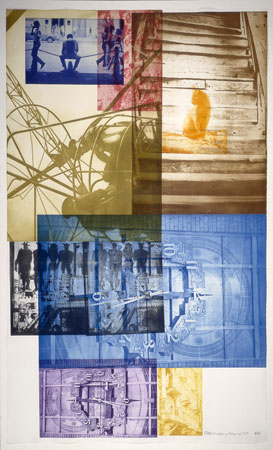
Soviet/American Array III, 1988
photogravure on wove paper
National Gallery of Art, Washington, Gift of Universal Limited Art Editions and the Artist
Beginning in the early 1960s, Robert Rauschenberg (American, born 1925) created painterly prints filled with images he clipped from newspapers and magazines. Nearly a decade earlier he had countered the introspective canvases of abstract expressionism with works he called "Combines," fusions of painting and sculpture that incorporate everyday items and embrace the cacophony of daily life. Rauschenberg's prints likewise introduced the commonplace in varied forms—a water ring left by a drinking glass, an embossment from a coin, or the traced outline of a walking cane. The artist's welcoming of representation back into the avant-garde restored a potent visual vocabulary. As art historian Leo Steinberg noted, "What he invented above all was...a pictorial surface that let the world in again."
Rauschenberg's open-ended approach helped steer fine art print studios in new directions. Working collaboratively with talented printers, he challenged the limits of methods and materials: rethinking customary approaches to lithography, screenprint, and intaglio; adopting new processes such as digital imaging; and printing on unconventional papers, cardboard, fabric, and plastic. Rauschenberg's foray into printmaking was a seemingly natural development, for imprinting—the very essence of printmaking—had long played a role in his work, in the form of fingerprints impressed in his paintings and magazine images transferred to drawings. Publisher Tatyana Grosman of Universal Limited Art Editions (ULAE) on Long Island, New York, was the first to invite Rauschenberg to make prints. He accepted the invitation in 1962, and his relationship with that atelier continues to the present.
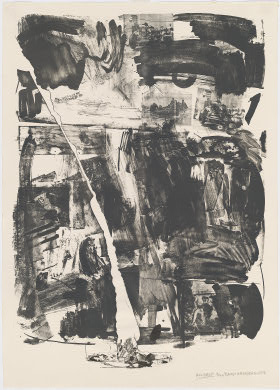
lithograph
Published by Universal Limited Art Editions, West Islip, New York
National Gallery of Art,
Gift of the Woodward Foundation, Washington, DC, 1976
Accident
Rauschenberg's embrace of the unexpected and his adeptness at turning chance to an advantage are underscored in his early ULAE print Accident. He produced only a handful of impressions before the lithographic stone broke in the course of printing. Rather than start again on another stone, he welcomed the rupture — visible as the long diagonal crack that bisects the final edition impression — and further embellished the image with scavenged limestone chips inked and printed in the lower margin. By titling the work Accident, Rauschenberg drew attention to the eccentric act of printing from a broken stone. By granting status to a random act, he was adapting strategies comparable to those of his colleague, the composer John Cage, who incorporated random tones and intervals into his musical compositions. When published, Accident garnered first prize in a major international print competition and brought unprecedented attention to an artist and atelier from the United States.
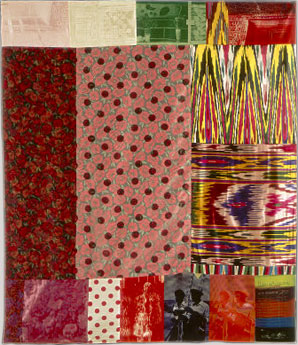
sewn fabric collage with screenprint
National Gallery of Art, Gift of Gemini G.E.L. and the Artist, 1991
Cultural Interchange
Travel has prompted Rauschenberg to experiment with a host of uncommon art materials, some exotic and others so familiar as to be often overlooked. In 1952 he visited Morocco and Italy, where he used the cardboard packaging found in men's laundered shirts as the support for collages composed of printed and cut papers, ribbons, feathers, and other discarded or surplus items—scrappy mergers of figurative and abstract elements that anticipated his subsequent Combines. Almost forty years later, in 1990, Rauschenberg revisited these works in the Shirtboards portfolio: twenty-eight meticulous replications of the 1952 collages. Printed by Styria Studio in New York using lithography and screenprint, the Shirtboards are fifty percent larger than the original works but otherwise are faithful to their models, mimicking even the glue stains and wrinkles of the originals.

Travel also has spurred collaboration and cultural exchange with artists and craftspeople abroad. Rauschenberg is committed to international peace and believes that "one-to-one contact through art" can be an effective tool in bridging differences. In 1984 he launched Rauschenberg Overseas Culture Interchange (ROCI), a massive undertaking in which photographs, paintings, sculpture, and videos were created and exhibited in eleven countries, from Mexico to Malaysia, and culminated in a 1991 exhibition at the National Gallery of Art, Washington. Included within the ROCI project was the series of prints entitled Soviet/American Array, which brought together photographs he took in the Soviet Union with ones he took in the United States, symbolically connecting cultures that long had been at odds.L.A. Uncovered #12, 1998
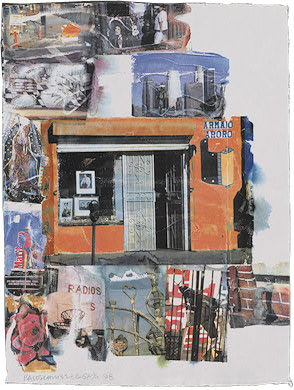
Published by Gemini G.E.L.,
Los Angeles, California
National Gallery of Art Gift of Lee and Ann Fensterstock, 2000
Masterpieces
from Venice to L.A.
Rauschenberg often integrated photographs of everyday subjects with images of great works of art from the past. His Bellini series, printed and published by ULAE in 1987, includes some of the most beautiful examples of this type, featuring allegorical figures of virtue and vice adapted and enlarged from paintings by the Venetian Renaissance master Giovanni Bellini (c. 1430/1435 – 1516). Rauschenberg discarded many of the paintings' landscape backgrounds, replacing them with his own photographs. Indeed, partly because copyright issues were inhibiting his use of found images, around 1980 he began to use his own photographs almost exclusively in his art. In Bellini #2 the figure of Fortune-Melancholy with attendant putti is set among Rauschenberg's photographs of buildings, landscape, and architectural details. His skill as a colorist is apparent, revealing the influence of the great color theorist and artist Josef Albers, who was one of his teachers at North Carolina's Black Mountain College in the late 1940s.
 An effective method of reproducing photographs in fine art prints is photogravure, a process regularly used by Rauschenberg since the 1980s in prints made at ULAE. Photogravure is an intaglio process, meaning that depressions of varying depths are etched into a metal plate. These hollows hold the ink that is pressed onto the print support. Although photogravures can capture extremely fine detail, the procedures for coaxing rich, clearly articulated tone from the random-grain pattern on the photosensitized plate are difficult to master, especially if multiple plates are to be inked and aligned. The Bellini prints from 1987 used numerous color plates, each printed to produce a distinct image in broad, overlapping monochromatic passages. Street Sounds, made five years later, was far more complex, involving multiple plates in different colors, carefully aligned and printed in succession to create a full tonal range. Color photogravures of the magnitude and complexity of Street Sounds were unheard of before ULAE collaborated with Rauschenberg to develop and perfect them.
An effective method of reproducing photographs in fine art prints is photogravure, a process regularly used by Rauschenberg since the 1980s in prints made at ULAE. Photogravure is an intaglio process, meaning that depressions of varying depths are etched into a metal plate. These hollows hold the ink that is pressed onto the print support. Although photogravures can capture extremely fine detail, the procedures for coaxing rich, clearly articulated tone from the random-grain pattern on the photosensitized plate are difficult to master, especially if multiple plates are to be inked and aligned. The Bellini prints from 1987 used numerous color plates, each printed to produce a distinct image in broad, overlapping monochromatic passages. Street Sounds, made five years later, was far more complex, involving multiple plates in different colors, carefully aligned and printed in succession to create a full tonal range. Color photogravures of the magnitude and complexity of Street Sounds were unheard of before ULAE collaborated with Rauschenberg to develop and perfect them.
In the late 1990s Rauschenberg took to the streets of Los Angeles with his camera, seeking the extraordinary in the familiar yet often disregarded urban landscape. He documented a kaleidoscope of hand-painted murals, billboard advertisements, storefronts, street signs, and myriad other subjects. These colorful vignettes, which became the basis for a series entitled L.A. Uncovered, were originally shot on film, which was then converted to digital files at Gemini G.E.L. and printed out on paper using water-soluble inks (because of environmental concerns, Rauschenberg has moved away from oil-based inks that require hazardous solvents). The artist then laid his digital printouts face down on water-saturated artist's paper. In a variation on his early solvent-transfer drawings, he burnished the printouts from the reverse, transferring the ink irregularly onto the print support. Depending on how much water had been absorbed, the resulting images ranged from sharply detailed to fluid and diffuse. These images were later scanned and made into screenprints.
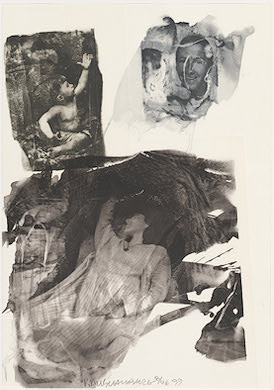
photogravure
Published by Universal Limited Art Editions, Bay Shore, New York
National Gallery of Art, Gift of the Collectors Committee, 2002
Ruminations
Rauschenberg's collection of old photographs of family and friends, many of which he took himself, was the starting point for his Ruminations series from 1999. The print entitled 'topher features images of the artist, his former wife Susan Weil, and their son Christopher as a young boy. The images were transferred onto photosensitized metal plates and reconstituted by brushing on photographic developer in broad, painterly strokes. The vigorous mark-making and limited tonal palette that characterized Rauschenberg's early work is reprised here with a striking innovation: whereas the early prints featured gestural marks interspersed with photographic images, the new process allows the mark and image to merge as one. The Ruminations project shows Rauschenberg at his most meditative.
Throughout his career Rauschenberg has been quick to adopt new materials and methods, and he relishes the medium's unpredictability. To his mind, the technical and mechanical aspects of printmaking afford him a healthy distance from the process, allowing for spontaneous interventions. In addition, he recognizes the power of printmaking to reach broad audiences with multiple impressions. Rauschenberg continues to reach out to the world and let the world in, offering us matchless opportunities to appreciate its strange and unforeseen beauty.
'Exhibition > Painting&Prints' 카테고리의 다른 글
| 제8회 한국현대미술제(KCAF) (0) | 2008.03.20 |
|---|---|
| 문선 (0) | 2008.03.20 |
| 국대호 (0) | 2008.03.14 |
| 리찌슨의 상징과 은유( LIJISEN) (0) | 2008.03.14 |
| 권기수 (0) | 2008.02.23 |



